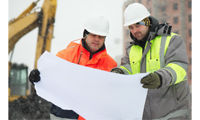

With recent long range weather forecasts suggesting the UK could be facing the coldest winter for almost a decade, roof systems manufacturer Marley is urging construction workers to get prepared for freezing winter temperatures.
Bitterly cold weather, ice and shorter periods of daylight mean there is a much greater risk of accidents on construction sites during the winter months. As well as the risk of slips and falls, prolonged exposure to the cold can cause construction workers to suffer from more colds, bronchitis, asthma, painful joints and fatigue. In extreme cases, workers outside for long periods, without the right protection, could even suffer hypothermia and frostbite.
Pete Flynn, health and safety advisor at Marley, explains: “While heavy snowfall usually brings work to a standstill, even the smallest amount of snow or ice can create major hazards and health risks on building sites. It is important that all construction workers understand the hazards of working in winter and know what precautions to take when cold weather sets in. Builders and sub-contractors must carry out their own thermal risk assessments and take appropriate action to protect their employees.”
So, how should construction workers prepare for winter weather?
For managers / supervisors…
1 - Monitor the weather forecast so you can anticipate and be prepared for poor weather conditions. Carry out a risk assessment every day to check it is safe to work and conditions haven’t changed. Pay particular attention to working at height platforms and do not work on roofs in icy conditions - this is a requirement of the Working at Height Regulations 2005.
2 - Make sure workers are trained on winter hazards and ensure they have the appropriate PPE.
3 - Limit worker exposure to cold through job rotation and provide plenty of breaks in heated areas with hot drinks available.
For site workers…
1 - Make sure you are wearing the right PPE and extra clothing suitable for the job and the weather conditions. This usually involves using several layers of clothing, as well as waterproofs or wind resistant fabrics where necessary. Also, choose water resistant footwear, with enhanced slip resistance or ice grips if required.
2 - Wear gloves when fine manual dexterity is not required and the temperature drops below 4°C.
3 - Cold weather increases the risk of hand-arm vibration syndrome, so keep your hands and arms warm when using vibratory equipment such as drills, nails guns and even hand tools, such as hammers.
4 - Choose hats that work with safety headgear and don't compromise any eye or hearing protection.
5 - Be aware of the symptoms of cold exposure – heavy shivering, uncomfortable coldness, numbness, aching, severe fatigue, confusion, drowsiness and/or euphoria.
6 - With reduced daylight hours, visibility can be a problem, so wear reflective PPE.
7 - Take breaks in heated areas and drink plenty of fluids, including water and warm beverages.
8 - Report any hazardous areas to the site manager and do not put yourself at risk just to complete a job.
To help prepare for freezing temperature, Marley is giving away hundreds of winter goodies. To apply for one of 500 free flasks, heat pads or ear bands, visit www.marley.co.uk/wintercampaign and fill in your details.